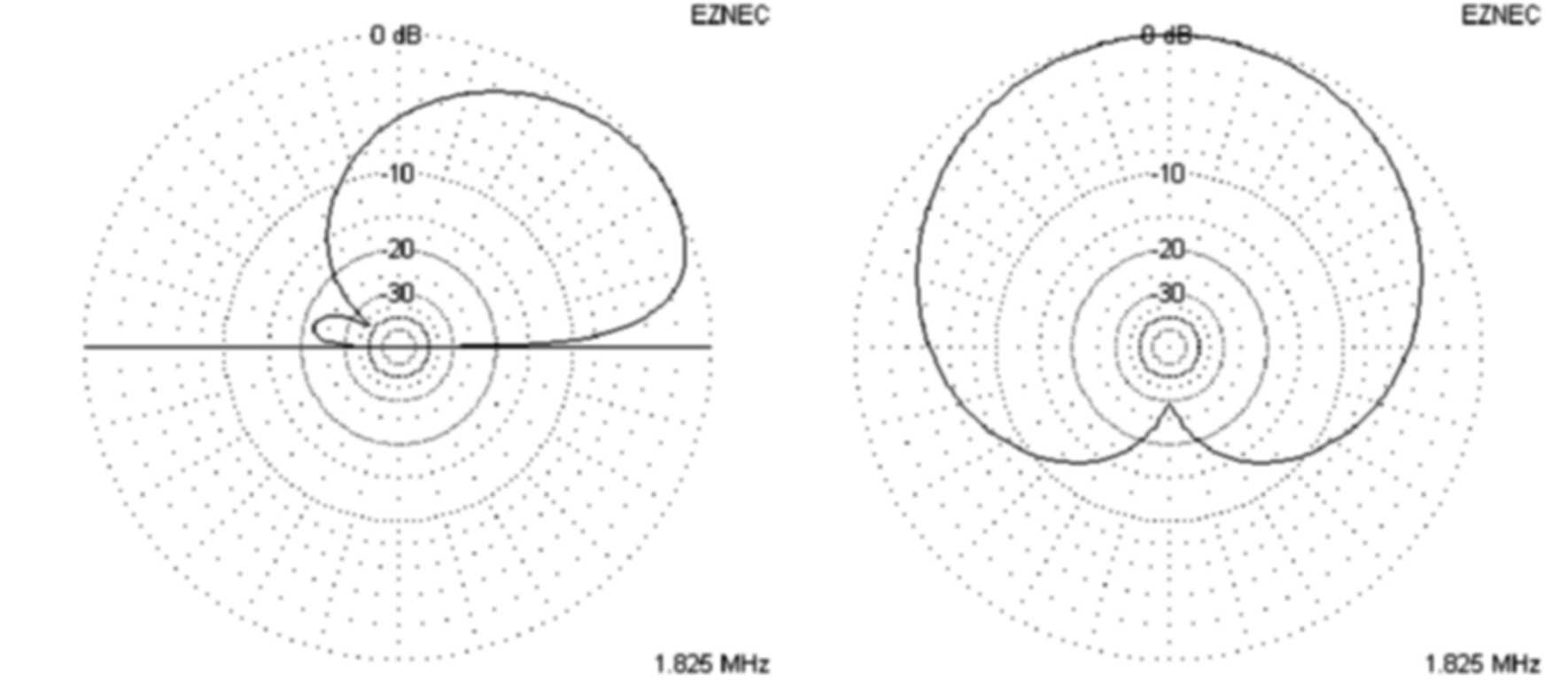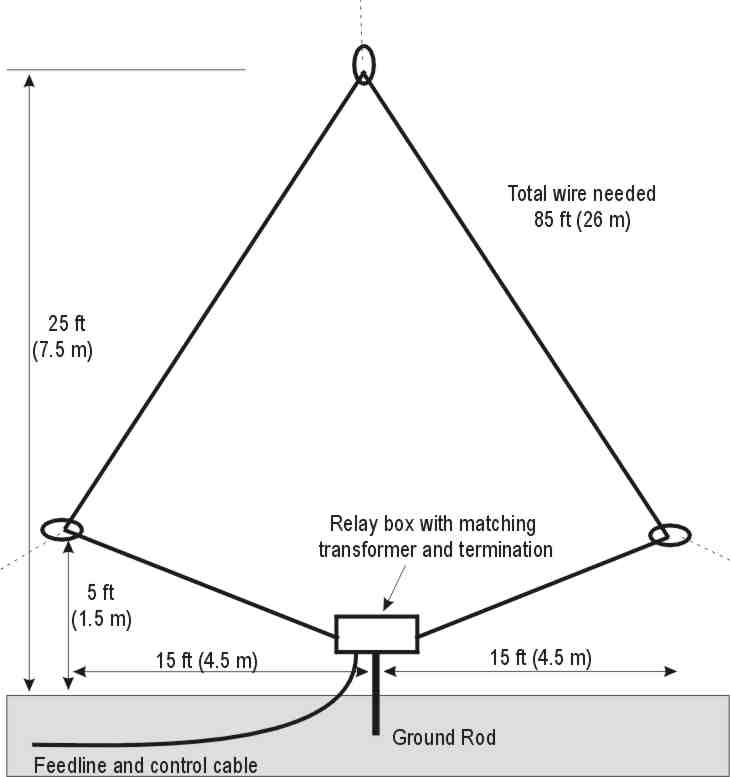

How to Build the K9AY Loop Receiving Antenna
Gary Breed,
K9AY
AY Technologies
E-mail: gary@aytechnologies.com
The AY Technologies AYL-4 K9AY Loop Control system provides the electronic portion
of the K9AY Loop receiving antenna system. Here are the instructions for constructing
the loop itself. If you don't want to make the loop using 'homebrew' construction,
we also offer the AYL-M kit that includes a mast, wire and all the hardware
needed to construct the antenna.
Terminated Loop Basics
The K9AY Loop is one of several published designs that use a terminated loop
to get a directional pattern in a small space. The EWE, Pennant, Flag and others
all operate using the same principle as the K9AY Loop, and they all provide
a cardioid pattern with one deep null. In simplest terms, these antennas are
very small phased arrays, with the vertical (or mostly vertical) portions being
the main elements. The termination resistance balances the currents to provide
the best possible null. It is also possible to explain the loop's behavior in
terms of its response to the E-field and H-field components of the arriving
wave, but this is more complicated than necessary!
The main advantage of the K9AY Loop is that the feedpoint and termination are at the same location. Simple switching lets you instantly reverse the pattern direction by exchanging the feed and termination. Using the AYL-4 unit and two crossed loops, 4 different directions can be selected, giving you the greatest flexibility in reducing interference and hearing the signal you want. Switching from one direction to another can mean the difference between solid copy and a signal covered up by interfering stations!
Horizontal and vertical radiation patterns of the K9AY Loop over average ground:

Construction Details
A single loop that will cover the 160 and 80 meter ham bands requires one 25-foot
high support and 85 feet of wire. The basic layout is shown here:
Construction of a single K9AY Loop:

The matching transformer and terminating resistor are located in the AYL-4 relay
box, so you only need to install the basic wire loop, its support and insulators,
plus the ground rod. The support can be a tree limb, a strong mast, or anything
else that will hold the loop in place.
The AYL-4 4-way loop control system uses two of these loops, sharing the same central support, but oriented at right angles to one another. The relay box changes pattern by switching the feedpoint and termination connections-front-to-back by reversing the ends of a loop; 90-degrees by switching from one loop to the other.
Locating Your K9AY Loops
Since you have chosen a small receiving antenna, it is likely that your transmitting
antenna will be nearby. Transmitting antennas, power lines, towers and other
nearby large conducting objects can re-radiate signals that are coupled to the
receiving antenna. To avoid this problem, locate the K9AY Loop as far from the
transmitting antenna as possible. Because the loop is small, it is often possible
to place it among trees or shrubs in a front or side yard, while the transmitting
antenna is in back. Another way to minimize the interaction is to locate the
loop toward the most important direction you want to hear. For example, if you
are most interested in hearing Europe from the US, locate the loop Northeast
of the transmitting antenna. When pointed toward Europe, the null will be in
the direction of the transmitting antenna, reducing the pickup of re-radiated
signals. Some European users of the K9AY Loop have chosen single loops, placing
one of them Northwest of the transmitting antenna to hear US stations, with
another East or Northeast to hear Asia and the Far East.
Grounding
A 4-foot ground rod (such as 3/4" diameter copper pipe) is often sufficient.
If the earth is very dry, a longer ground rod is advised, to reach permanently
moist earth-or you may install four or more 15- to 20-foot long radial wires
for better coupling to ground. The grounded design of the K9AY Loop has several
advantages over ground-independent versions of the terminated loop (Pennant
and Flag), including simpler switching, no feedline isolation problems, and
greater signal capture for the same size loops.
Preamplifier
All terminated loop antennas are inefficient, which means that signal levels
are low. The K9AY Loop requires about 15 dB of gain to restore signals to levels
similar to Beverage antennas. A preamplifier providing this gain, along with
excellent bandpass filtering for 1.75 to 4.5 MHz, is included with the AYL-4
systems. At 160 and 80 meters, coax loss is very low, so a preamp located at
the receiver is usually sufficient. In normal installations, we recommend against
an outdoor preamp, since it is exposed to greater risk of damage from static
discharge (lightning) or RF from nearby transmitting antennas. The most common
exception is with extremely long feedlines, where a preamp at the antenna will
boost the signal level to overcome coax losses and to increase the signal relative
to any common-mode noise and signals picked up by the long feedline.
Feedline and Control
Line Routing
As with all small receiving antennas, the low signal levels from the K9AY Loop
require careful routing of the coax feedline and control cables. The best solution
is to bury the cables and take advantage of the natural RF shielding of earth.
Second best is to simply lay them on the ground, which is often done when receiving
antennas are only connected during the Fall and Winter lowband DX season. We
strongly recommend against above-ground installation, but we know it is sometimes
unavoidable. If you believe that your feedline is affecting the pattern of the
loop, it probably indicates that your grounding is insufficient. In this case,
refer to the previous notes and other published data on grounding.
Using the K9AY Loop
on Other Frequencies
The K9AY Loop keeps its directional pattern at lower frequencies, making it
an excellent antenna for Medium Wave and Low Frequency DXing. Many Broadcast
Band DXers marvel at the way switching the pattern lets you hear different stations
on the same frequency. In some installations, the antenna may retain some directivity
above 5 MHz, but this should not be expected. The preamplifier provided includes
a bandpass filter that limits its use to approximately 1.75 to 4.5 MHz. A preamp
is rarely needed for Broadcast listening or for frequencies above 5 MHz. For
Low Frequency DXers, we can provide the AYL-4 without the highpass filter (no
extra charge for this special order), which allows the preamp to operate down
to 100 kHz or lower.
Installation Checklist (Problems experienced by some users):
1. The two loops in the
4-way system are completely separate--not connected at the top
2. The control cable is wired properly between the indoor control unit and the
outdoor relay unit
3. The antenna is properly connected to the ground rod
4. The two loops are connected properly-NOT "one end of loop A and one
end of loop B"
5. Proper control relay voltage
Enjoy your K9AY Loops!
AY Technologies * antennas
by K9AY * www.aytechnologies.com